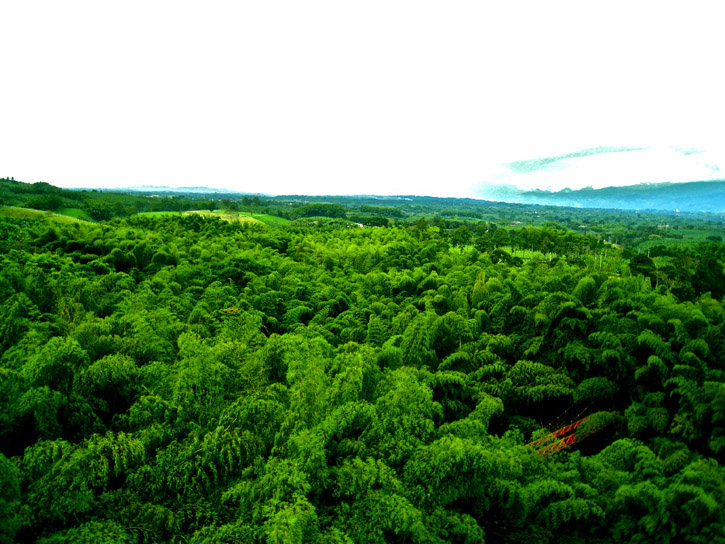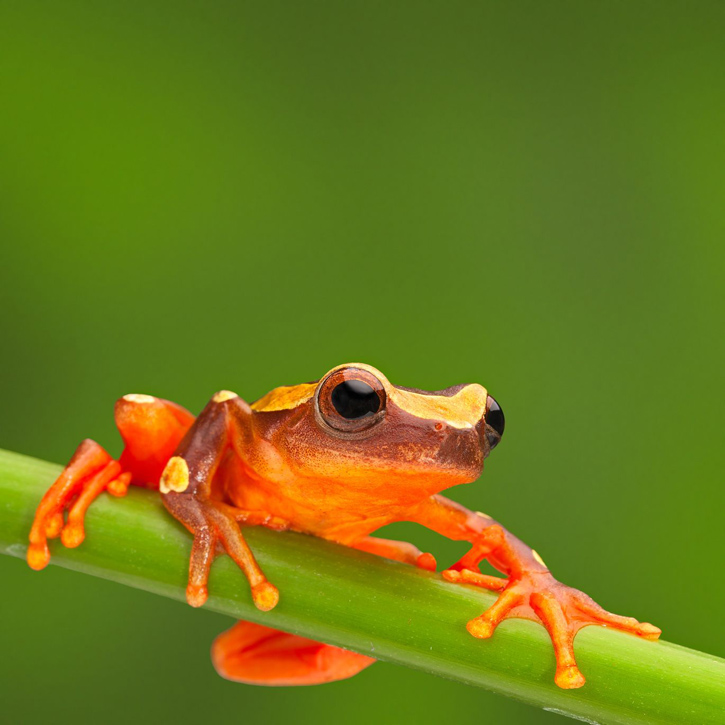Rainforests are among the most complex ecosystems on Earth. They have a layered structure with towering trees that soar 30-40 meters high to form the forest’s canopy. Some of the most common rainforest trees are the ceiba, mahogany, myrtle, laurel, acacia, and rubber trees. Occasionally, particularly high trees known as emergentes pierce the canopy, reaching as high up as 60 meters (200 feet). Below the canopy is the sotobosque, a middle layer of smaller trees and palms that vie for the sunlight filtering in through the canopy. In the canopy and sotobosque there are many epiphytes (plants such as orchids and bromeliads) that have adapted to live on top of trees so as to be nearer to the sunlight. Near the ground live plants that require little sunlight, including ferns, grasses, and many types of fungi. The two main rainforests in Colombia, the Amazon and the Chocó, have the same layered structure, though they have some differences in their flora and fauna.

The Amazon rainforest is considered the lungs of the world. Photo © najarich, licensed Creative Commons Attribution No-Derivatives.
Of Colombia’s 1,800 species of birds, more than 1,000 have been identified in the Chocó, including a large number of hummingbirds.The Amazon Rainforest is home to a large number of vertebrates. Over millennia, a large number of canopy-dwelling species evolved. Monkeys, such as the large and extremely agile spider monkey, the woolly monkey, and the howler monkey, evolved prehensile tails that allowed them to move easily from branch to branch. Anteaters, such as the tamandua and the oso mielero (giant anteater), and the incredibly cute kinkajú (kinkajou) also developed prehensile tails. Other inhabitants of the canopy include sloths, such as the adorable-looking three-toed sloth, whose strategy is not agility but passivity: It eats tree vegetation and is covered with algae which gradually turn it green to allow for good camouflage. The canopy is also home to myriad bats and many birds, including exotic eagles, curassows, toucans, woodpeckers, cotingas, and macaws.Notable is the majestic harpy eagle, with powerful claws and the ability to fly unencumbered through the canopy. It preys on monkeys and sloths, which it kills with the force of its claws. The tigrillo (tiger cat) is a small and extremely endangered species. It has a long tail that helps with its balance as it moves from tree to tree.
On the ground, large vertebrates include the extremely endangered tapir, an ancient mammal species that can grow two meters long (over six feet) and weigh 300 kilograms (660 pounds). It is equally at ease on land as in the water. Other land mammals include the giant armadillo, giant anteater, deer, and boars, such as the saíno and pecarí. Smaller mammals include the guatín and borugo, both rodents. These animals are often prey to the puma and jaguar, both of which inhabit the Amazon but are difficult to observe in the wild.
The rivers of the Amazon are home to more than 1,500 species of fish, including endangered pirarucú, one of the largest freshwater fishes on Earth. There are also dolphins, both pink and gray. The former evolved separately from the ocean-going dolphins when the Amazon was an inland sea. The Amazonian gray dolphins are sea dolphins that adapted to living in freshwater. Other aquatic mammals include the highly endangered manatee and otters.

Many species of frogs are active in the day and therefore relatively easy to spot. Photo © dirk ercken/123rf.
The Chocó Rainforest is particularly rich in palms, of which 120 species have been identified. In fact, it is sometimes referred to as the “Land of the Palms.” The forest also abounds in cycads, ancient plants that have a stout trunk and crowns of hard, stiff leaves. Chocó is also notable for more than 40 species of brightly colored poisonous frogs, known locally as ranas kokois. These small frogs are covered with a deadly poison and have evolved stunning coloring, from bright orange to red, gold, and blue. They are active in the day and therefore relatively easy to spot. Of Colombia’s 1,800 species of birds, more than 1,000 have been identified in the Chocó, including a large number of hummingbirds. Offshore, the Pacific welcomes the annual migration of Antarctic humpback whales. The beaches of the Pacific Coast are popular nesting areas for sea turtles, in particular the tortuga golfina (olive ridley) and tortuga carey (hawksbill) sea turtles. On the island of Gorgona 35 kilometers from the mainland, an unusual—and quite stunning—species of lizard is the blue anole lizard. Highly threatened, it is found only on Gorgona.
Excerpted from the First Edition of Moon Colombia.